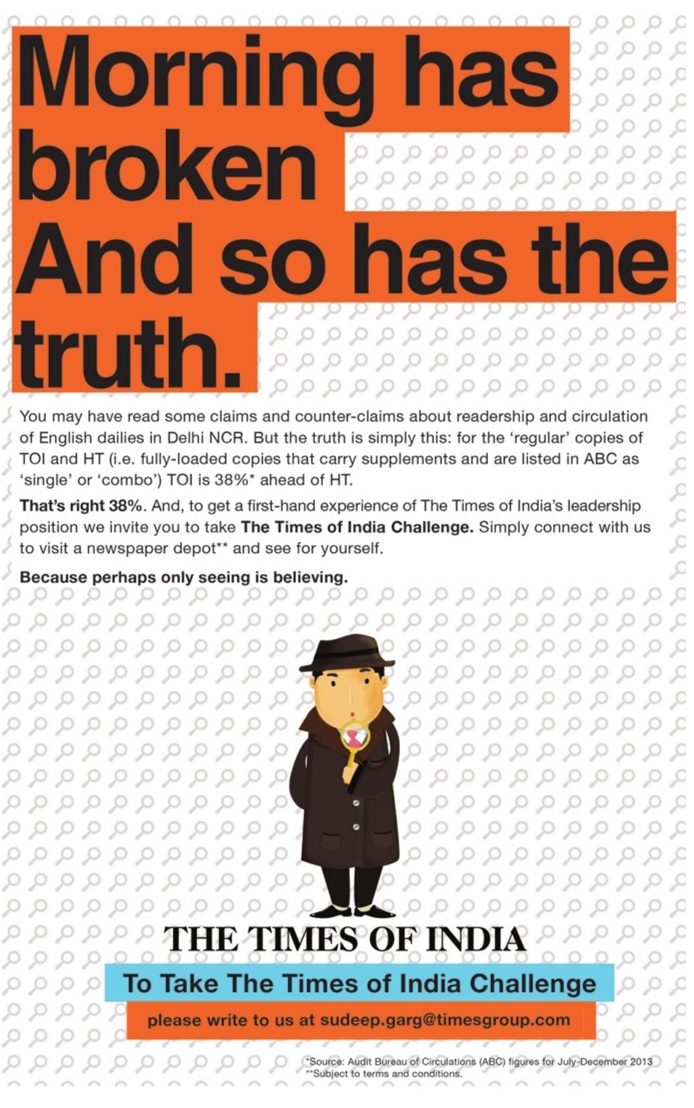Indian newspapers are generally reluctant to name each other, preferring to refer to each other with euphemisms like “a leading daily” or, if they want to be condescending, “a news outlet". So it’s always surprising to see the name of a rival on the front page of a newspaper, especially under a headline that screams, “Wake up to the truth.”
That's what readers of the Mumbai Mirror, published by the group that owns The Times of India, woke up to on Thursday. On Friday, the Mirror continued to slag off its rival on the front page. It runs an editorial that compares the HT circulation department to a character in M Night Shyamalan's film The Sixth Sense. “Perhaps, like Haley Joel Osment in Sixth Sense, they also see dead people,” said the editorial.
The Hindustan Times hit back by producing an animated video titled, "The Eternal Cry baby: Times of India."
Welcome to the Times of India-Hindustan Times rivalry, where none of the usual rules apply.
The two organisations have been locked in a pitched battle for years. For a long time time, their spheres of influence were somewhat discrete, with the ToI unimpeachable in Mumbai and HT the king in Delhi. The papers have even signed non-poaching pacts not to hire each other's employees, presumably to ensure salaries stay low despite their competition.
Over the last decade and a half, however, the Times has been on a crusade to become the country’s largest newspaper organisation, entering markets from Tamil Nadu to Kashmir. Around the same time, HT decided to enter the Mumbai market, where it now claims to have taken the number two spot.

This prompted a reply from the ToI’s sister tabloid, the Mumbai Mirror, on its front page on Thursday. “Contrary to reports you’ve been reading, Mumbai Mirror is miles ahead of HT and continues to dominate in the number two position,” the front-page splash ad, set against a red-tinted photo of the Times’ home neighbourhood in Mumbai. In its front page editorial on Friday, the Mirror declared:
For some time now Hindustan Times has been making tall claims to being the city's second-largest newspaper. At Mumbai Mirror, where we pride ourselves on hard-hitting investigative stories, we thought it was best that you, reader, turn investigator and see for yourself where the truth lies.
The editorial goes on to discuss circulation numbers, which refer to how many copies are sold as well readership numbers, which is an estimate of how many people read the publications. The Mirror claims it beats HT at circulation, 6 lakh versus 4.14 lakh, and even take a price competition jab by mentioning that these figures from the Registrar for Newspapers for India were taken when HT’s prices were very low. HT has increased their prices since then, a tactic that the Times itself has used across the country to price out competitors.
Moreover, the Mirror mocks HT’s readership numbers, which would imply that 5.4 people are reading each copy of the newspaper. “A median household in a city like Mumbai comprises four people (including babies) so where does that 5.4 come from? (In some other towns they have even claimed readership of ten per copy). Perhaps, like Haley Joel Osment in Sixth Sense, they also see dead people.”
This isn’t a one-way battle though. Even before the “Wake up to the Truth” ad, there was an odd article in the Hindustan Times in Delhi titled “Whodunit: Removing HT market copies to win 'morning challenge'?”
HT takes a much more coy approach, choosing not to name the Times of India and, instead, reports that its circulation department has been getting complaints from thousands of readers about copies of its paper disappearing.
The HT’s circulation department, which began a trail from the press to the reader, stumbled upon a startling fact: a group of people were descending upon various distribution centers early in the morning, and buying up thousands of copies of HT, sometimes at more than double the cover price.
It goes on to question why anyone would be doing this and then mentions that a “competition newspaper” had recently launched a morning challenge. That challenge, of course, features the usual Times of India approach to taking on its competitor in Delhi. It was inspired by HT’s claim that it is the top newspaper in the National Capital Region, something the Times “could not digest.”

The spat can be traced back many, many years. But just this year alone, ToI’s sister paper, the Economic Times, wrote in June that the Indian Readership Survey’s number had “foxed the industry.” This prompted a bylined response from HT and eventually the morning challenge ads. Crucially, both the ToI Delhi’s campaign as well as the Mumbai Mirror ads are explicitly targetted at advertisers not just readers, with the “challenge” itself being for advertisers to come to the distribution centres and witness the numbers games themselves.












